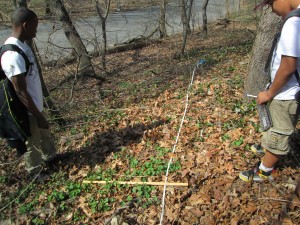Surveying Garlic Mustard

Originally appears in the Winter 2015 issue
TEACHING AND LEARNING about invasive species in students’ local places can peak students interest in caring for the environment. My ninth grade students and I partnered with the Prospect Park Landscape Management Department to engage in a place-based learning experience in our local urban park in Brooklyn, New York to study the invasive plant species Garlic mustard (Alliaria petiolata). In this article, I describe how we investigated Garlic mustard in the hopes that it will enable you to replicate the
project in your community.
Garlic mustard poses a severe threat to native plant communities in eastern and midwest North America. Originating in Europe and Asia, Garlic mustard is thought to have been brought to the United States to be used for medicinal purposes and food. It was first reported growing in Long Island, NY in 1868 and has since spread from the Northeast United States throughout North America. It grows aggressively, even in poor soil conditions, and competes with native plants for sunlight, nutrients, water, soil, and space. A biennial plant that takes two years to complete its life cycle. In the first year it forms rosettes close to the ground and in the second year it grows into a flowering plant. One plant produces anywhere from 600-7,900 seeds, which are then mainly dispersed by animals and humans. Garlic mustard has a distinctive smell, much like the garlic you buy at the grocery store, when the leaves are crushed. It is not eaten by wildlife like the native plants, so it often replaces them in great quantity, quickly taking over the understory of a forest and reducing the biodiversity of ecosystems. This invasive species can usually be controlled by pulling the plant and making sure not to spread the seeds.
The Prospect Park Landscape Management Department monitors the growth of Garlic mustard and organizes the park’s volunteers to “pull” the plants in order to control their growth. The Landscape Management Department met with my ninth grade Field Studies class at Brooklyn Academy of Science and the Environment (BASE High School) to explain how to identify Garlic mustard, and enlist the class to survey the plants populations in several locations within the 585 acre urban park. The class was tasked with determining its spread and detecting locations in which to organize a “group pull” of the plant. This project introduced students to concepts of invasive species, plant identification, and using transects for field research in the local urban park.
To view the photo-rich magazine version, click here.
If you are not already a subscriber, please subscribe to read the full article
Amy DeFelice recently completed her doctoral degree at the City University of New York Graduate Center in Urban Education. She is currently a visiting assistant professor in the Department of Teaching, Learning, and Leadership at Long Island University’s Brooklyn campus and previously taught at the Brooklyn Academy of Science and the Environment.
This is an expanded version of an article that appeared in Green Teacher’s latest book Teaching about Invasive Species.
Leave a Reply
You must be logged in to post a comment.





